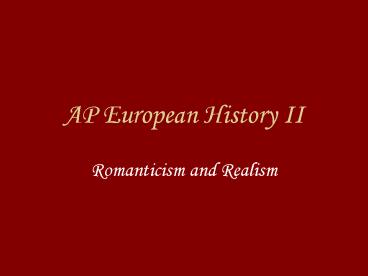AP European History II - PowerPoint PPT Presentation
1 / 38
Title:
AP European History II
Description:
Emphasis on emotion, sentiment, and inner feelings ... Friedrich - Crows. Friedrich Wanderer Above a Sea of Fog. b) Joseph Mallord William Turner ... – PowerPoint PPT presentation
Number of Views:33
Avg rating:3.0/5.0
Title: AP European History II
1
AP European History II
- Romanticism and Realism
2
VI. Romanticism and Realism
- A. Romanticism
- 1. Common characteristics
- Emphasis on emotion, sentiment, and inner
feelings - Individualism - an interest in the unique traits
of each person - Romantic heroes - the deeds of heroes determined
the outcome of historical events - Interest in the past
- Love of nature
3
2. Specific examples
- a. Literature
- 1) Johann Wolfgang von Goethe (1749-1832)
- a) Numerous plays and novels where
- the plots involved young maidens
tragically carried off at an early age to - the sorrow and sadness of their male
lovers - b) The Sorrows of the Young Werther
4
2) Walter Scott (1771-1832) a) Europe's
best-seller in the first half of the nineteenth
century b) Ivanhoe
5
3) Mary Shelley (1797-1851)
- a) Symbolized the danger of science when it tries
to conquer nature - b) Bizarre and unusual that gives rise to Gothic
literature - c) Frankenstein
6
b. Poetry
- 1) Ranked above all other literally forms
because poets believed poetry was the direct
expression of one's soul - 2) Romantic poets would have nothing to do with
deist God of the Enlightenment - 3) Criticized science that placed nature as a
cold object of study
7
a) William Wordsworth
- (1) Love of nature
- (2) Nature served as a mirror into which humans
could look to learn about themselves
8
b. Art and Music
- 1) Two fundamental characteristics
- a) A painting should mirror the artist's
- vision of the world - it is a reflection of
- the artist's inner feelings
- b) Romantic artists deliberately
- rejected the principles of Classicism -
- they abandon the restraint on warmth,
emotion, and movement - 2) Specific examples
9
a) Caspar David Friedrich (1774-1840)
- (1) Preoccupied with God and nature
- (2) Paintings tend to have mystery and mysticism
themes
10
(3) Man and Woman Gazing at the Moon
11
Friedrich - Crows
12
Friedrich Wanderer Above a Sea of Fog
13
b) Joseph Mallord William Turner (1775-1851)
- (1) Painted numerous landscapes, seascapes,
sunrises, and sunsets - (2) He did not idealize nature, he painted its
moods by using light and color to suggest natural
effects
14
(3) Rain, Steam, and Speed-The Great Western
Railway
15
Turner - Cowes, Isle of Wight
16
Turner - Chichester Canal
17
c) Eugène Delacroix (1798-1863)
- (1) Passion for color and historical subjects
- (2) The Death of Sardanapalus
18
Delacroix Liberty Leading the People
19
d) Ludwig van Beethoven (1770-1827)
- Considered one of the greatest composers of music
- Wrote a nationalistic piece for Napoleon
- Eventually he became deaf
20
Symphony No 5 Allegro con brio
21
Für Elise
22
"Moonlight" Sonata Adagio sostenuto
23
Minuet
24
e) Hector Berlioz (1803-69)
- (1) One of the founders of programmed music
- (2) Symphonie Fantastique most famous piece
25
B. Realism
- 1. Common characteristics
- Deal with ordinary characters from real life
rather than Romantic heroes in unusual settings - Avoidance of flowery and sentimental language by
using careful observation and accurate
description - Deliberate rejection of Romanticism
26
2. Specific examples
- a. Literature
- 1) Charles Dickens (1812-70)
- a) Novels focused on the lower and
middle classes - b) Realistic depictions of the urban poor
and the brutalization of the human life
27
b. Art
- 1) France became the leaders in Realist painting
- 2) Gustave Courbet (1819-77)
- a) The word Realism was first coined to
describe one of his paintings - b) His subjects were factory workers,
peasants, and the wives of saloon keepers
28
c) The Stonebreakers
29
Courbet The Source
30
Courbet The Bather
31
Courbet Burial at Ornans
32
3) Jean-François Millet (1814-75)
- a) Painted mostly scenes from rural
- life, especially peasants laboring in the fields
33
b) The Gleaners
34
Millet Shepherdess with Her Flock
35
Millet The Angelus
36
c. Music
- 1) The New German School emphasized emotional
content rather than using abstract forms and new
methods of using music to express literary or
pictorial ideas
37
2) Franz Liszt (1811-86)
- a) Child prodigy
- b) He has been called the greatest pianists of
all time - c) Credited with creating the piano recital
- d) Under his guidance and the New German School,
Romantic music reached its peak
38
3) Richard Wagner (1813-83)
- a) Composer and promoter of his music
- b) Transformed opera into music drama
- c) Many of his themes in his work looked to myth
and epic tales from the past

